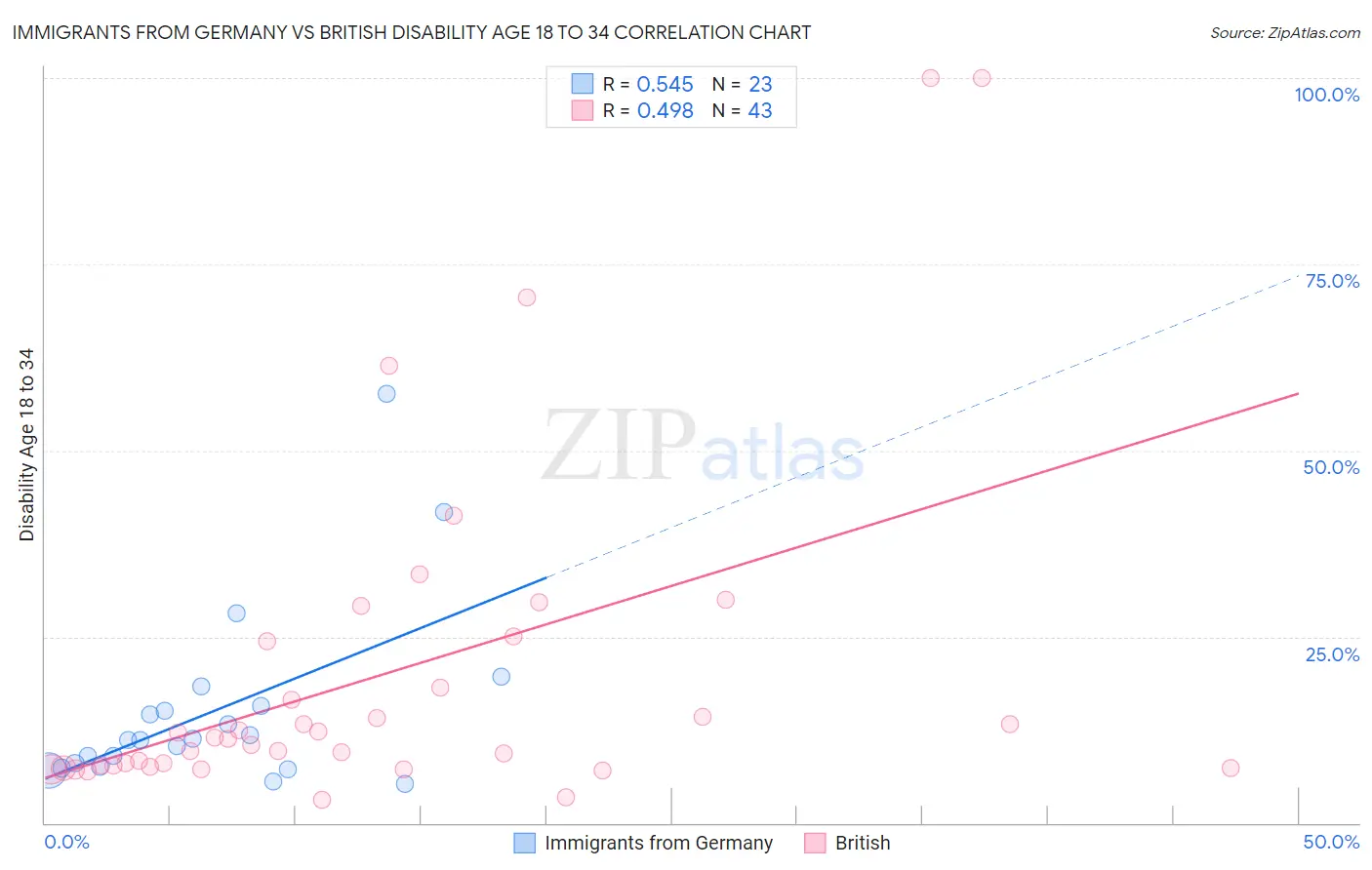Immigrants from Germany vs British Disability Age 18 to 34
COMPARE
Immigrants from Germany
British
Disability Age 18 to 34
Disability Age 18 to 34 Comparison
Immigrants from Germany
British
7.2%
DISABILITY AGE 18 TO 34
0.4/ 100
METRIC RATING
255th/ 347
METRIC RANK
7.3%
DISABILITY AGE 18 TO 34
0.2/ 100
METRIC RATING
263rd/ 347
METRIC RANK
Immigrants from Germany vs British Disability Age 18 to 34 Correlation Chart
The statistical analysis conducted on geographies consisting of 462,223,204 people shows a substantial positive correlation between the proportion of Immigrants from Germany and percentage of population with a disability between the ages 18 and 35 in the United States with a correlation coefficient (R) of 0.545 and weighted average of 7.2%. Similarly, the statistical analysis conducted on geographies consisting of 528,221,956 people shows a moderate positive correlation between the proportion of British and percentage of population with a disability between the ages 18 and 35 in the United States with a correlation coefficient (R) of 0.498 and weighted average of 7.3%, a difference of 1.4%.

Disability Age 18 to 34 Correlation Summary
| Measurement | Immigrants from Germany | British |
| Minimum | 5.3% | 3.0% |
| Maximum | 57.7% | 100.0% |
| Range | 52.4% | 97.0% |
| Mean | 15.0% | 19.9% |
| Median | 11.1% | 11.2% |
| Interquartile 25% (IQ1) | 7.6% | 7.5% |
| Interquartile 75% (IQ3) | 15.7% | 24.4% |
| Interquartile Range (IQR) | 8.1% | 16.9% |
| Standard Deviation (Sample) | 12.4% | 22.8% |
| Standard Deviation (Population) | 12.1% | 22.5% |
Demographics Similar to Immigrants from Germany and British by Disability Age 18 to 34
In terms of disability age 18 to 34, the demographic groups most similar to Immigrants from Germany are Indonesian (7.2%, a difference of 0.020%), Immigrants from Laos (7.2%, a difference of 0.030%), Czech (7.2%, a difference of 0.30%), Croatian (7.2%, a difference of 0.31%), and Polish (7.2%, a difference of 0.57%). Similarly, the demographic groups most similar to British are Bermudan (7.3%, a difference of 0.25%), Slovene (7.3%, a difference of 0.28%), Canadian (7.3%, a difference of 0.29%), Northern European (7.3%, a difference of 0.32%), and German Russian (7.4%, a difference of 0.44%).
| Demographics | Rating | Rank | Disability Age 18 to 34 |
| Malaysians | 0.7 /100 | #249 | Tragic 7.2% |
| Fijians | 0.6 /100 | #250 | Tragic 7.2% |
| Spaniards | 0.6 /100 | #251 | Tragic 7.2% |
| Poles | 0.6 /100 | #252 | Tragic 7.2% |
| Croatians | 0.5 /100 | #253 | Tragic 7.2% |
| Indonesians | 0.4 /100 | #254 | Tragic 7.2% |
| Immigrants | Germany | 0.4 /100 | #255 | Tragic 7.2% |
| Immigrants | Laos | 0.4 /100 | #256 | Tragic 7.2% |
| Czechs | 0.3 /100 | #257 | Tragic 7.2% |
| Immigrants | Micronesia | 0.3 /100 | #258 | Tragic 7.3% |
| Somalis | 0.2 /100 | #259 | Tragic 7.3% |
| Tohono O'odham | 0.2 /100 | #260 | Tragic 7.3% |
| Northern Europeans | 0.2 /100 | #261 | Tragic 7.3% |
| Canadians | 0.2 /100 | #262 | Tragic 7.3% |
| British | 0.2 /100 | #263 | Tragic 7.3% |
| Bermudans | 0.1 /100 | #264 | Tragic 7.3% |
| Slovenes | 0.1 /100 | #265 | Tragic 7.3% |
| German Russians | 0.1 /100 | #266 | Tragic 7.4% |
| Bangladeshis | 0.1 /100 | #267 | Tragic 7.4% |
| Portuguese | 0.1 /100 | #268 | Tragic 7.4% |
| Basques | 0.1 /100 | #269 | Tragic 7.4% |